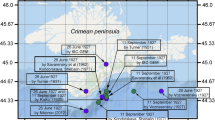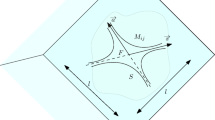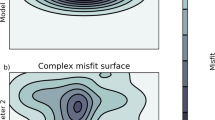Summary
In the last few years many improvements have been realized on the application of inverse methods to seismology. Increasing attention has been payed to simulataneous inversion methods, allowing us to determine hypocentral parameters and velocity models using data from a set of earthquakes recorded by dense seismic arrays. Since the first studies by Peters and Crosson, Crosson and Aki and Lee, recently Thurber, Pavlis, Spencer-Gubbins developed new techniques which are more efficient and practicable also with moderate-size computers. In the first part of this paper a review of all these recent inversion methods in presented starting with the simple location algorithms, to come to the most sophisticated simultaneous inversion methods. For shortness the discussion is restricted to the so-called «overdetermined» problem in which the velocity model is parametrized by a finite number of parameters. A brief appendix about the most powerful mathematical inversion techniques is also presented. In the second part, we present a study on the precision and the accuracy of some location algorithms, used to relocate aftershocks by using a temporary seismic array installed soon after the 1980 Southern Italy earthquake. This study remarks the important role of network geometry and the use of accurate algorithms for identifying earthquakes rupture zones.
Riassunto
Negli ultimi anni è stato dato un forte impulso all'applicazione dei metodi di inversione alla sismologia. Particolare attenzione è stata posta nei metodi di «inversione simultanea» che permettono di determinare parametri ipocentrali e modelli di velocità usando i dati provenienti da insiemi di terremoti registrati da fitte reti locali. I primi studi in questo campo si denovo a Peters e Crosson, Crosson ed Aki e Lee. Recentemente Spencer e Gubbins, Thurber e Pavlis hanno sviluppato nuove tecniche che sono piú efficienti e praticabili anche con piccoli calcolatori. Nella prima parte di questo articolo presentiamo un'esposizione dei piú recenti metodi d'inversione iniziando dai moderni algoritmi di localizzazione per arrivare ai piú sofisticati metodi di inversione simultanea. Per brevità la nostra discussione sarà ristretta al cosiddetto «problema sovradeterminato» in cui il modello di velocità è specificato mediante un numero finito di parametri. In appendice è contenuta una breve introduzione sulle piú efficaci tecniche matematiche d'inversione. Nella seconda parte, presentiamo uno studio sulla precisione ed attendibilità degli algoritmi di localizzazione usati per localizzare le repliche del terremoto irpino-lucano del 1980, registrate con una rete sismica locale installata poco tempo dopo l'evento principale. Questo studio sottolinea il ruolo importante che una buona geometria della rete e l'uso di accurati algoritmi d'inversione rivestono nell'identificazione delle zone di rottura associate ad eventi sismici.
Резюме
В последние несколько лет были реализованы различные улучшения методов решения обратной проблемы сейсмологии. Особое внимание уделяется методам одновременной инверсии, позволяющим определить параметры гипоцентра, и скоростным моделям, использующим данные системы землетрясений, зарегистрированных с помощью плотных сейсмических цепочек. Со времени первых исследований Питерса и Кроссона, Кроссона и Аки и Ли, недавно были предложены =qnовые методики Турбером, Паулисом, Спенсером-Губинсом, которые являются более эффективными, а также используют компьютеры средних размеров. В первой части этой работы предлагается обзор всех методов инверсии, начиная с простых алгоритмов локализации и переходя к наиболее сложным методам одновременной инверсии. Рассмотрение ограничено так называемой «переопределенной» проблемой, где скоростная модель параметризуется с помощью конечного числа параметров. В приложении приведены наиболее мощные математические методы инверсии. Во второй части проводится анализ точности некоторых алгоритмов локализации, которые применяются для повторной локализации последующих толчков, используя временную сейсмическую систему, установленную вскоре после землетрясения 1980 г. в Южной Италии. Отмечается важная роль геометрии пространственной структуры и использования точных алгоритмов для идентификации землетрясений в зонах разлома.
Similar content being viewed by others
References
L. Geiger:Bull. St. Louis Univ.,8, 60 (1912).
D. C. Peters andR. S. Crosson:Bull. Seismol. Soc. Am.,62, 775 (1972).
R. S. Crosson:J. Geophys. Res.,81, 3036 (1976).
K. Aki andW. H. K. Lee:J. Geophys. Res.,81, 4381 (1976).
C. H. Thurber: Ph.D. Thesis, M.I.T. (1981).
G. L. Pavlis andJ. R. Booker:J. Geophys. Res.,85, 4801 (1980).
A. Tarantola andB. Valette:J. Geophys. Res.,50, 159 (1982).
A. Tarantola andB. Valette:Rev. Geophys. Space Phys.,20, 2, 219 (1982).
C. Spencer andD. Gubbins:Geophys. J. R. Astron. Soc.,63, 95 (1980).
G. L. Pavlis: Ph.D. Thesis, Washington University (1982).
G. Backus andJ. F. Gilbert:Geophys. J. R. Astron. Soc.,16, 169 (1968).
G. Backus andJ. F. Gilbert:Philos. Trans. R. Soc. London, Ser. A,266, 123 (1970).
C. Lanczos:Linear Differential Operators (Van Nostrand-Reinhold, Princeton, N. J., 1961).
K. Levenberg:Q. Appl. Math.,2, 164 (1944).
D. W. Marquardt:Technometrics,12, 591 (1970).
E. H. Moore:Bull. Am. Meteorol. Soc.,26, 394 (1920).
R. Penrose:Proc. Cambridge Philos. Soc.,51, 406 (1955).
R. A. Wiggins:Rev. Geophys Space Phys.,10, 251 (1972).
B. A. Bolt:Geophys. J. R. Astron. Soc. Am.,60, 1823 (1960).
E. A. Flinn:Bull. Seismol. Soc. Am.,50, 467 (1960).
J. M. Nordquist:Bull. Seismol. Soc. Am.,52, 431 (1962).
W. H. K. Lee andS. W. Stewart:Principles and application of microearthquake networks, inAdvances in Geophys. (Academic Press, New York, N. Y., 1981).
K. Aki andP. Richards:Quantitative Seismology. Theory and Methods (Freeman, San Francisco, Cal., 1980).
W. H. K. Lee andJ. C. Lahr: U.S.G.S. Open file report (1972).
T. H. Jordan: Ph.D. Thesis, C.I.T., Pasadena (1972).
C. W. Chou andJ. R. Booker:Geophys. J. R. Astron. Soc.,59, 325 (1979).
K. H. Jacob:J. Geophys. Res.,75, 6675 (1970).
B. R. Julian:Ray Tracing in Arbitrarily Heterogeneous Media, Tech. Note 1970, 45 Lincoln Lab. M.I.T., Cambridge (1970).
R. L. Wesson:Bull. Seismol. Soc. Am.,61, 729 (1971).
B. R. Julian andD. Gubbins:J. Geophys. Res.,43, 95 (1977).
V. Pereyra, W. H. K. Lee andH. B. Keller:Bull. Seismol. Soc. Am.,70, 79 (1980).
F. Luk, R. Comer andW. H. K. Lee: in press (1982).
E. Turco:Rend. Soc. Geol. Ital.,4, 451 (1981).
R. Westaway andJ. Jackson:Nature, in press (1984).
S. Arca, V. Bonasia, R. Gaulon, F. Pingue, J. F. Ruegg andR. Scarpa:Boll. Geod. Sci. Aff.,42, 137 (1983).
R. Berardi, A. Berenzi andF. Capozza: inContributo alla caratterizzazione della sismicità del territorio italiano, ENEA-ENEL, Roma (1981).
E. Boschi, F. Mulargia, E. Mantovani, M. Bonafede, A. M. Dziewonski andJ. H. Woodhouse:E.O.S. (abstract),62(17), 330 (1981).
W. Brustle andG. Muller:Phys. Earth Planet. Int.,32., 312 (1983).
A. Deschamps andG. C. P. King:Earth Planet. Sci. Lett.,62, 296 (1984).
I. Nakanishi andH. Kanamori:Bull. Seismol. Soc. Am.,74, 805 (1984).
K. Aki:J. Geophys. Res.,89, 5867 (1984).
P. Reasenberg andW. L. Ellsworth:J. Geophys. Res.,87, 10637 (1982).
A. Deschamps, G. Iannaccone andR. Scarpa:Ann. Geophys.,2, 29 (1984).
M. Ouyed, G. Yielding, D. Hatzfeld andG. C. P. King:Geophys. J. R, Astron. Soc.,73, 605 (1983).
E. Del Pezzo, G. Iannaccone, M. Martini andR. Scarpa:Bull. Seismol. Soc. Am.,73, 187 (1983).
A. Deschamps andG. C. P. King:Bull. Seismol. Soc. Am., in press (1984).
G. De Natale, M. Martini andE. Terzini:Atti del II Convegno Nazionale Geofisico della Terra Solida, C.N.R., Roma (1984).
R. S. Crosson: Tech. Rep. Univ. of Washington, Seattle (1981).
C. L. Lawson andR. J. Hanson:Solving Least Squares Problems (Prentice Hall, Englewood Cliffs, N. J., 1974).
G. E. Forsythe andC. B. Moler:Computer Solutions of Linear Algebraic Systems (Prentice Hall, Inc., Englewood Cliffs, N. J., 1967).
Author information
Authors and Affiliations
Rights and permissions
About this article
Cite this article
De Natale, G., Scarpa, R. & Terzini, E. Earthquake location inverse problem: a review and an application to the aftershocks of the Southern Italy 23 November 1980 earthquake. Il Nuovo Cimento C 8, 1–25 (1985). https://doi.org/10.1007/BF02507699
Received:
Revised:
Issue Date:
DOI: https://doi.org/10.1007/BF02507699




